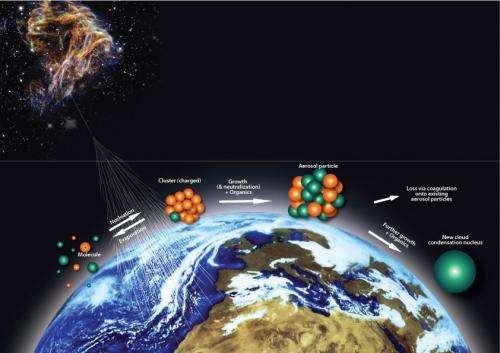August 25, 2011 report
CERN CLOUD research team adds new pieces to puzzle of cloud formation

(PhysOrg.com) -- Jasper Kirkby, a physicist at CERN and colleagues have built an experimental climate chamber to measure the impact of cosmic rays on aerosol creation to mimic the creation of clouds in Earth's atmosphere. So far, as the team describes in their paper published in Nature, there appears to be some evidence of aerosol creation, but not enough to account for cloud formation, and thus there’s no evidence yet to show that cosmic rays have an impact on global temperatures.
Kirkby notes that despite widespread debate about the possible link between cosmic rays (charged particles , mostly protons thought to originate from exploding supernovae) and global temperature variations, very little is actually known about how aerosols are formed, which means, nobody really understands cloud formation. Thus the debate is rather philosophical, rather than scientific. To help bring some clarity to the issue, he and his team set up an experiment at the site of the Large Hadron Collider because it can provide artificial cosmic rays.
The experiment (called Cosmics Leaving Outdoor Droplets - CLOUD) consisted of building a climate chamber; a three meter diameter stainless steel drum pumped full of purified wet air, sulphur dioxide, ozone and ammonia gases, placing it in the path of a stream of charged-pion beams, and then standing back to watch what happens under varying temperatures.
Initial results from the experiment showed that the bombardment of cosmic rays do indeed cause a change in the creation of aerosols; in fact, by more than a factor of ten. But, even that is not nearly enough to show that they contribute to cloud formation, much less climate change.
The reason some theorists believe that cosmic rays have an impact on Earth temperatures is because the amount of such rays vary over time due to the magnetic effect of the Sun. During times of high solar activity, such magnetism serves to shield the Earth from some of the rays, while times of lower solar activity allows more to reach us. It’s possible some say, that times of higher or lower exposure to cosmic rays might explain global temperature variations , if it’s true that cosmic rays contribute to cloud formation (via buildup of aerosols) that reflect heat back into space.
Though this most recent experiment doesn’t really answer the question of whether cosmic rays are having an impact on our weather, it does open the door to more research. Kirkby and his team plan to follow up their research with more variables with the goal of creating actual clouds in their chamber and eventually, hopefully, settling things once and for all.
More information: Role of sulphuric acid, ammonia and galactic cosmic rays in atmospheric aerosol nucleation, Nature 476, 429–433 (25 August 2011) doi:10.1038/nature10343
Abstract
Atmospheric aerosols exert an important influence on climate through their effects on stratiform cloud albedo and lifetime and the invigoration of convective storms. Model calculations suggest that almost half of the global cloud condensation nuclei in the atmospheric boundary layer may originate from the nucleation of aerosols from trace condensable vapours4, although the sensitivity of the number of cloud condensation nuclei to changes of nucleation rate may be small. Despite extensive research, fundamental questions remain about the nucleation rate of sulphuric acid particles and the mechanisms responsible, including the roles of galactic cosmic rays and other chemical species such as ammonia. Here we present the first results from the CLOUD experiment at CERN. We find that atmospherically relevant ammonia mixing ratios of 100 parts per trillion by volume, or less, increase the nucleation rate of sulphuric acid particles more than 100–1,000-fold. Time-resolved molecular measurements reveal that nucleation proceeds by a base-stabilization mechanism involving the stepwise accretion of ammonia molecules. Ions increase the nucleation rate by an additional factor of between two and more than ten at ground-level galactic-cosmic-ray intensities, provided that the nucleation rate lies below the limiting ion-pair production rate. We find that ion-induced binary nucleation of H2SO4–H2O can occur in the mid-troposphere but is negligible in the boundary layer. However, even with the large enhancements in rate due to ammonia and ions, atmospheric concentrations of ammonia and sulphuric acid are insufficient to account for observed boundary-layer nucleation.
Press release, Videos courtesy CERN.
© 2011 PhysOrg.com

















